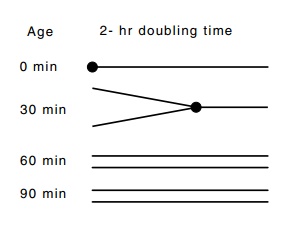Chapter: Genetics and Molecular Biology: DNA Synthesis
Constancy of the E. coli DNA Elongation Rate - Physiological Aspects
Constancy of the E. coli DNA Elongation Rate
Determining the strategy that cells use to adjust
DNA replication to different growth rates once again utilizes measurement of
the numbers of gene copies. Consider two cell types, one with a doubling time
of 1 hour and one with a doubling time of 2 hours. If each cell type requires
the full doubling time to replicate its chromosome, then the distributions of
structures of replicating chromosomes extracted from random populations of
cells growing at the two different rates would be identical (Fig. 3.16.).
However, if both cell types replicate their chromosomes in 1 hour, then the
cells with the 1-hour doubling time will possess a different distribution of
chromosome structures than the cells with the 2-hour doubling time (Fig. 3.17).
The problem, once again, is that of counting copies of genes. Measuring the
number of copies of genes located near the origin and of genes located near the
terminus of replication permits these two possible DNA replication schemes to
be distinguished.
Figure 3.16 States of chromosomes of cells with 1-hour and 2-hour doublingtimes assuming 1 hour or 2 hours are required to replicate the DNA. The ratio of copies of genes near the replication origin and replication terminus are the same for cells growing with the two rates.

Instead of measuring numbers of copies of genes by
transduction frequencies, the more precise method of DNA hybridization could be
used because the locations of the origin and terminus were known. DNA

Figure
3.17 States of chromo-somes in cells
with a 2-hour doubling time, assuming only 1 hour is required for replication
of the chromosome. The ratio of the number of copies of genes near the
replication origin and terminus is different than if 2 hours were re-quired for
replication of the DNA.
was
extracted from the cells, denatured, and immobilized on filter paper. Then an
excess of a mixture of 3H-labeled DNA fragment from the origin and 14C-labeled
DNA fragment from the terminus region was added and allowed to hybridize to the
single-stranded DNA on the filters. When all hybridization to the immobilized
DNA was completed, the filters were washed free of unannealed DNA and the ratio
of bound 3H to 14C radioactivity was determined by liquid
scintillation counting. This ratio reflects the ratio of the number of origins
and termini in the culture of cells from which the DNA was extracted. The ratio
could be measured using DNA extracted from cells growing at various growth
rates. It showed that for cell doubling times in the range of 20 minutes to 3
hours the chromosome doubling time remained constant at about 40 minutes.
The
constancy of the chromosome doubling time raises new prob-lems, however. How do
the cells manage to keep DNA replication and cell division precisely
coordinated, and how can DNA replication, which requires 40 minutes, manage to
keep up with cell division if cells are dividing in less than 40 minutes?
Related Topics